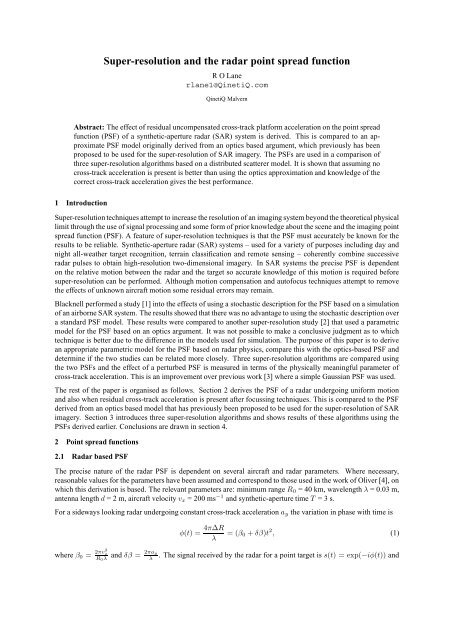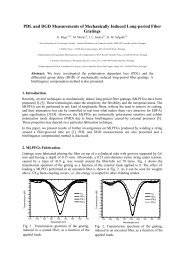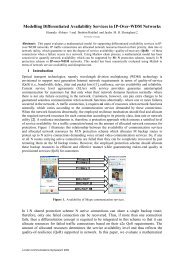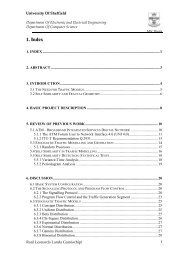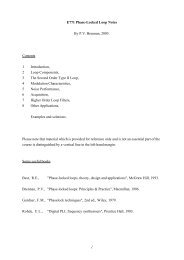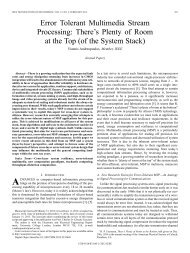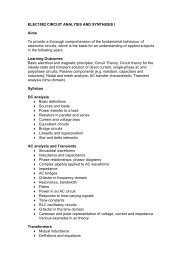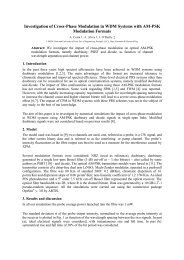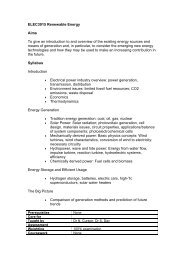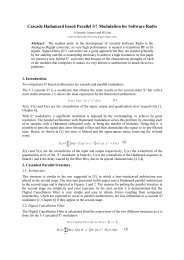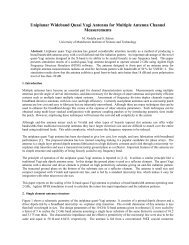Super-resolution and the radar point spread function - UCL ...
Super-resolution and the radar point spread function - UCL ...
Super-resolution and the radar point spread function - UCL ...
You also want an ePaper? Increase the reach of your titles
YUMPU automatically turns print PDFs into web optimized ePapers that Google loves.
<strong>Super</strong>-<strong>resolution</strong> <strong>and</strong> <strong>the</strong> <strong>radar</strong> <strong>point</strong> <strong>spread</strong> <strong>function</strong>R O Lanerlane1@QinetiQ.comQinetiQ MalvernAbstract: The effect of residual uncompensated cross-track platform acceleration on <strong>the</strong> <strong>point</strong> <strong>spread</strong><strong>function</strong> (PSF) of a syn<strong>the</strong>tic-aperture <strong>radar</strong> (SAR) system is derived. This is compared to an approximatePSF model originally derived from an optics based argument, which previously has beenproposed to be used for <strong>the</strong> super-<strong>resolution</strong> of SAR imagery. The PSFs are used in a comparison ofthree super-<strong>resolution</strong> algorithms based on a distributed scatterer model. It is shown that assuming nocross-track acceleration is present is better than using <strong>the</strong> optics approximation <strong>and</strong> knowledge of <strong>the</strong>correct cross-track acceleration gives <strong>the</strong> best performance.1 Introduction<strong>Super</strong>-<strong>resolution</strong> techniques attempt to increase <strong>the</strong> <strong>resolution</strong> of an imaging system beyond <strong>the</strong> <strong>the</strong>oretical physicallimit through <strong>the</strong> use of signal processing <strong>and</strong> some form of prior knowledge about <strong>the</strong> scene <strong>and</strong> <strong>the</strong> imaging <strong>point</strong><strong>spread</strong> <strong>function</strong> (PSF). A feature of super-<strong>resolution</strong> techniques is that <strong>the</strong> PSF must accurately be known for <strong>the</strong>results to be reliable. Syn<strong>the</strong>tic-aperture <strong>radar</strong> (SAR) systems – used for a variety of purposes including day <strong>and</strong>night all-wea<strong>the</strong>r target recognition, terrain classification <strong>and</strong> remote sensing – coherently combine successive<strong>radar</strong> pulses to obtain high-<strong>resolution</strong> two-dimensional imagery. In SAR systems <strong>the</strong> precise PSF is dependenton <strong>the</strong> relative motion between <strong>the</strong> <strong>radar</strong> <strong>and</strong> <strong>the</strong> target so accurate knowledge of this motion is required beforesuper-<strong>resolution</strong> can be performed. Although motion compensation <strong>and</strong> autofocus techniques attempt to remove<strong>the</strong> effects of unknown aircraft motion some residual errors may remain.Blacknell performed a study [1] into <strong>the</strong> effects of using a stochastic description for <strong>the</strong> PSF based on a simulationof an airborne SAR system. The results showed that <strong>the</strong>re was no advantage to using <strong>the</strong> stochastic description overa st<strong>and</strong>ard PSF model. These results were compared to ano<strong>the</strong>r super-<strong>resolution</strong> study [2] that used a parametricmodel for <strong>the</strong> PSF based on an optics argument. It was not possible to make a conclusive judgment as to whichtechnique is better due to <strong>the</strong> difference in <strong>the</strong> models used for simulation. The purpose of this paper is to derivean appropriate parametric model for <strong>the</strong> PSF based on <strong>radar</strong> physics, compare this with <strong>the</strong> optics-based PSF <strong>and</strong>determine if <strong>the</strong> two studies can be related more closely. Three super-<strong>resolution</strong> algorithms are compared using<strong>the</strong> two PSFs <strong>and</strong> <strong>the</strong> effect of a perturbed PSF is measured in terms of <strong>the</strong> physically meaningful parameter ofcross-track acceleration. This is an improvement over previous work [3] where a simple Gaussian PSF was used.The rest of <strong>the</strong> paper is organised as follows. Section 2 derives <strong>the</strong> PSF of a <strong>radar</strong> undergoing uniform motion<strong>and</strong> also when residual cross-track acceleration is present after focussing techniques. This is compared to <strong>the</strong> PSFderived from an optics based model that has previously been proposed to be used for <strong>the</strong> super-<strong>resolution</strong> of SARimagery. Section 3 introduces three super-<strong>resolution</strong> algorithms <strong>and</strong> shows results of <strong>the</strong>se algorithms using <strong>the</strong>PSFs derived earlier. Conclusions are drawn in section 4.2 Point <strong>spread</strong> <strong>function</strong>s2.1 Radar based PSFThe precise nature of <strong>the</strong> <strong>radar</strong> PSF is dependent on several aircraft <strong>and</strong> <strong>radar</strong> parameters. Where necessary,reasonable values for <strong>the</strong> parameters have been assumed <strong>and</strong> correspond to those used in <strong>the</strong> work of Oliver [4], onwhich this derivation is based. The relevant parameters are: minimum range R 0 = 40 km, wavelength λ = 0.03 m,antenna length d = 2 m, aircraft velocity v x = 200 ms −1 <strong>and</strong> syn<strong>the</strong>tic-aperture time T = 3 s.For a sideways looking <strong>radar</strong> undergoing constant cross-track acceleration a y <strong>the</strong> variation in phase with time isφ(t) = 4π∆Rλ= (β 0 + δβ)t 2 , (1)where β 0 = 2πv2 xR 0λ2πay<strong>and</strong> δβ = . The signal received by <strong>the</strong> <strong>radar</strong> for a <strong>point</strong> target is s(t) = exp(−iφ(t)) <strong>and</strong>λ
<strong>the</strong> matched filter output is given by <strong>the</strong> cross-correlation of this with a reference signal h ∗ (t) = exp(iβ 0 t 2 ):g(t) = 1 T= 1 T∫ T/2−T/2∫ T/2−T/2s(t + τ)h ∗ (τ)dτ (2)exp [ −i(β 0 + δβ)(t + τ) 2 + iβ 0 τ 2] dτ (3)= 1 T exp [ −i(β 0 + δβ)t 2] ∫ T/2exp [ −i(β 0 + δβ)2tτ − iδβτ 2] dτ. (4)−T/2For zero cross-track acceleration δβ=0 <strong>and</strong> this simplifies to <strong>the</strong> familiar sinc <strong>function</strong> g(t) = sinc(β 0 T t)×exp(−iβ 0 t 2 ). When <strong>the</strong> cross-track acceleration is non-zero <strong>the</strong> integral in (4) can be Fourier transformed togiveIfπ(β 0+δβ)T ≪ T 2I(ω) = 1 T=∫ T/2−T/2∫ T/2−T/2exp ( −iδβτ 2) ∫ T/2exp [−i(β 0 + δβ)2tτ] exp(iωt)dtdτ (5)exp ( −iδβτ 2) sincan expression proportional to <strong>the</strong> Dirac delta <strong>function</strong> δ−T/2([(β 0 + δβ)2τ − ω] T 2)dτ. (6), which holds well for <strong>the</strong> parameters used here, <strong>the</strong>n <strong>the</strong> sinc <strong>function</strong> may be approximated by()τ − <strong>and</strong>ω2(β 0+δβ)[ ] −iδβω2I(ω) ∝ exp4(β 0 + δβ) 2 . (7)The inverse Fourier transform of this <strong>function</strong> cannot be evaluated in terms of simple <strong>function</strong>s. However, <strong>the</strong>analytical form when using integration limits ω = ±W/2 is given by Ma<strong>the</strong>matica 4.0 [5] as√ π(−1) 1/4 [(β 0 + δβ)I(t) ∝W √ i(β0 + δβ) 2 t 2 ]exp× ... (8)δβδβ{ [ [ (−1)3/44(β 0 + δβ) 2 t − δβW ] ] [ [ (−1)3/44(β 0 + δβ) 2 t + δβW ] ]}erfi4 √ δβ(β 0 + δβ)− erfi4 √ δβ(β 0 + δβ)where erfi(z) = erf(iz)/i <strong>and</strong> erf(z) = (2/ √ π) ∫ z0 exp(−t2 )dt. This can be substituted for <strong>the</strong> integral in (4) togive <strong>the</strong> desired PSF as a <strong>function</strong> of time. To obtain <strong>the</strong> PSF in spatial co-ordinates t is replaced with x/v x .2.2 Optics based PSFIn <strong>the</strong> paper by Luttrell [2] it is stated that a SAR system undergoing anomalous motion can in first order bemodelled as <strong>the</strong> defocussing of a simple linear imaging system. The <strong>point</strong> <strong>spread</strong> <strong>function</strong> is given asg(x) = 1 2c∫ +c−cexp(ikx + iθk 2 x 2 )dk. (9)The paper goes on to make a linear approximation valid when |θc 2 x 2 | ∼ < 1 to solve this analytically. It is stated thatfor super-<strong>resolution</strong> within <strong>the</strong> main lobe |x| < π/c <strong>and</strong> it is required that |θ| ∼ < 0.1. However, it should be notedthat in practice <strong>the</strong> image obtained from a <strong>radar</strong> will also contain energy in <strong>the</strong> side-lobes <strong>and</strong> ei<strong>the</strong>r a much smallervalue of θ should be used, which would limit <strong>the</strong> range of motion that can be accomodated, or <strong>the</strong> approximationwould have to be be exp<strong>and</strong>ed to quadratic or higher orders of θ. If <strong>the</strong> approximation were exp<strong>and</strong>ed <strong>the</strong>n Luttrell’sautofocus/super-<strong>resolution</strong> algorithm would no longer apply because it depends on a PSF linear in θ. It is in factpossible to evaluate <strong>the</strong> integral (9) in terms of special <strong>function</strong>s <strong>and</strong> is given by Ma<strong>the</strong>matica as:g(x) = (−1)3/4 e −i/(4θ)√ π4c √ θx2.3 PSF comparison[erfi( (−1) 1/4 (1 − 2cθx)2 √ θ)− erfi( (−1) 1/4 (1 + 2cθx)2 √ θ,)]. (10)A comparison between <strong>the</strong> optics model <strong>and</strong> <strong>the</strong> <strong>radar</strong> cross-track acceleration model was made by setting integrationlimits such that <strong>the</strong> -3dB <strong>resolution</strong> with no distortion was 1m for both models, setting θ to various values
0.90.80.70.6δβ / s −20.50.40.30.20.100 0.01 0.02 0.03 0.04 0.05 0.06 0.07 0.08 0.09 0.1θ (dimensionless)Figure 1: Relationship between defocus parameters0−5RadarOptics0−5RadarOptics−10−10|PSF| (dB)−15|PSF| (dB)−15−20−20−25−25−30−10 −8 −6 −4 −2 0 2 4 6 8 10Position (m)−30(a) θ = 0.02, δβ = 0.207s −2 (b) θ = 0.10, δβ = 0.831s −2−10 −8 −6 −4 −2 0 2 4 6 8 10Position (m)Figure 2: Comparison of <strong>radar</strong> <strong>and</strong> optics PSFs for two levels of defocus<strong>and</strong> <strong>the</strong>n adjusting δβ until <strong>the</strong> two PSFs had <strong>the</strong> same first side-lobe level. The corresponding values of θ <strong>and</strong> δβare displayed in Figure 1 showing a mildly non-linear relationship between <strong>the</strong> two defocus parameters. From <strong>the</strong>graph <strong>and</strong> using <strong>the</strong> assumed <strong>radar</strong> parameters, <strong>the</strong> residual cross-track acceleration corresponding to θ=0.1 (<strong>the</strong>value used in [2], [6], [7] <strong>and</strong> [8]) is 4.0×10 −3 ms −2 .Examples of <strong>the</strong> PSFs are shown in Figures 2a <strong>and</strong> 2b where θ=0.02 <strong>and</strong> 0.10 respectively. For θ=0.02 <strong>the</strong> levelof defocus is low <strong>and</strong> <strong>the</strong> two PSFs are similar both to each o<strong>the</strong>r <strong>and</strong> to a completely focussed sinc <strong>function</strong> (notshown) for <strong>the</strong> first few side-lobes. However, at larger distances from <strong>the</strong> main lobe <strong>the</strong> PSFs start to diverge with<strong>the</strong> optics PSF showing more distortion. For θ=0.10 <strong>the</strong> PSFs are substantially different. The optics PSF has amuch higher level of distortion <strong>and</strong> <strong>the</strong> first side-lobe is no longer <strong>the</strong> strongest. In comparison, <strong>the</strong> <strong>radar</strong> crosstrackacceleration PSF has deteriorated only slightly <strong>and</strong> is still similar to a sinc <strong>function</strong>. The <strong>resolution</strong> of <strong>the</strong>two PSFs degraded by about 3.6% for θ = 0.10 <strong>and</strong> 5.0% for δβ = 0.831s −2 .3 <strong>Super</strong>-<strong>resolution</strong> resultsThree st<strong>and</strong>ard super-<strong>resolution</strong> algorithms are tested here: inverse (INV), singular value decomposition (SVD)<strong>and</strong> thresholded minimum mean square error (MMSE-T). An overview of <strong>the</strong>se algorithms <strong>and</strong> o<strong>the</strong>rs includingBayesian super-<strong>resolution</strong> [6] is given in [8]. A super-<strong>resolution</strong> performance metric is <strong>the</strong> output signal-to-noiseratio defined as SNR out = ||f|| 2 /|| ˆf − f|| 2 , where f is <strong>the</strong> true high-<strong>resolution</strong> scene <strong>and</strong> ˆf is <strong>the</strong> estimatedscene using any particular algorithm. A Monte Carlo assessment has been carried out using measured SAR data.A high-<strong>resolution</strong> target image of 27x33 pixels had its <strong>resolution</strong> degraded using <strong>the</strong> cross-track acceleration PSFwith δβ = 0.831s −2 <strong>and</strong> noise was added at an SNR of 30dB. Each super-<strong>resolution</strong> algorithm was <strong>the</strong>n executedusing <strong>the</strong> correct cross-track acceleration PSF, <strong>the</strong> optical PSF with <strong>the</strong> correct first side-lobe level (θ = 0.10), <strong>and</strong>a sinc PSF. This was repeated 100 times <strong>and</strong> <strong>the</strong> mean <strong>and</strong> st<strong>and</strong>ard deviations of <strong>the</strong> output SNR were measured.Results of <strong>the</strong> assessment are shown in Table 1. The <strong>radar</strong> PSF gives <strong>the</strong> best performance for SVD <strong>and</strong> MMSE-T,which are <strong>the</strong> most reliable algorithms. This is to be expected as cross-track acceleration is <strong>the</strong> correct model usedin <strong>the</strong> simulation. Using <strong>the</strong> optics PSF gives a worse performance than using a sinc <strong>function</strong>. This is because <strong>the</strong>optics PSF is less similar to <strong>the</strong> sinc <strong>function</strong> than <strong>the</strong> <strong>radar</strong> PSF. Example imagery before <strong>and</strong> after super-<strong>resolution</strong>using MMSE-T <strong>and</strong> <strong>the</strong> <strong>radar</strong> PSF is shown in Figure 3.4 ConclusionsA <strong>radar</strong> <strong>and</strong> optics PSF have been compared using analytic expressions for <strong>the</strong> <strong>function</strong>s. The effect of using <strong>the</strong>optics PSF during super-<strong>resolution</strong> when <strong>the</strong> actual PSF is due to cross-track acceleration was found to be worsethan using an idealised sinc <strong>function</strong> when no cross-track acceleration is present. Out of <strong>the</strong> algorithms testedMMSE-T was <strong>the</strong> best using <strong>the</strong> output SNR metric, which confirms previous results [8]. The best super-<strong>resolution</strong>
Radar PSF Optics PSF Sinc PSFAlgorithm Mean S.D. Mean S.D. Mean S.D.INV -11.83 1.16 -1.46 0.31 -4.16 1.10SVD 8.85 0.08 2.14 0.03 8.10 0.11MMSE-T 10.52 0.44 2.22 0.10 8.19 1.40Table 1: Output SNR in dBFigure 3: Original, blurred <strong>and</strong> super-resolved imagesmetric for an automatic target recognition (ATR) application would be overall classification performance, whichhas been used in [7] <strong>and</strong> [9].Finally it should be noted that effects o<strong>the</strong>r than anomalous motion between <strong>the</strong> <strong>radar</strong> <strong>and</strong> target may alter <strong>the</strong>PSF. Phase noise or non-linearities due to imperfections of <strong>the</strong> <strong>radar</strong> receiver, quantisation noise <strong>and</strong> atmosphericphase disturbances all increase side-lobe levels. Also, scattering centres whose properties vary with frequency<strong>and</strong> imaging geometry result in non-ideal PSFs. These effects would fur<strong>the</strong>r reduce <strong>the</strong> performance of st<strong>and</strong>ardsuper-<strong>resolution</strong> algorithms.AcknowledgmentsThis work was sponsored by <strong>the</strong> EPSRC Engineering Doctorate programme <strong>and</strong> <strong>the</strong> UK Ministry of DefenceCorporate Research Programme. c○ Copyright QinetiQ Ltd 2005.References[1] D. Blacknell <strong>and</strong> S. Quegan, “SAR super-<strong>resolution</strong> using a perturbed <strong>point</strong> <strong>spread</strong> <strong>function</strong>,” IGARSS,pp. 2592–2595, July 1989.[2] S. P. Luttrell, “A Bayesian derivation of an iterative autofocus/super<strong>resolution</strong> algorithm,” Inverse Problems6(6), pp. 975–996, 1990.[3] R. O. Lane, “Estimating <strong>radar</strong> cross section using Bayesian image restoration,” Proceedings of <strong>the</strong> LondonCommunications Symposium, pp. 1–4, September 2003.[4] C. J. Oliver, “Syn<strong>the</strong>tic-aperture <strong>radar</strong> imaging,” J. Phys. D: Appl. Phys. 22, pp. 871–890, 1989.[5] S. Wolfram, The Ma<strong>the</strong>matica Book, Wolfram Media/CUP, 4th ed., 1999.[6] R. O. Lane, K. D. Copsey, <strong>and</strong> A. R. Webb, “A Bayesian approach to simultaneous autofocus <strong>and</strong> super<strong>resolution</strong>,”Proc. of SPIE vol. 5427, Algorithms for syn<strong>the</strong>tic aperture <strong>radar</strong> imagery XI, pp. 133–142, April2004.[7] K. D. Copsey, R. O. Lane, <strong>and</strong> A. R. Webb, “Designing NCTR algorithms when operating sensor conditionsdiffer from training conditions,” International conference on <strong>radar</strong> systems (Radar2004), Toulouse, France,October 2004.[8] R. O. Lane, K. D. Copsey, <strong>and</strong> A. R. Webb, “Assessment of a Bayesian approach to recognising relocatabletargets,” NATO RTO SET-096 specialists’ meeting on <strong>the</strong> millimeterwave advanced target recognition <strong>and</strong>identification experiment (MATRIX 2005), Oberammergau, Germany, May 2005.[9] L. M. Novak, G. J. Owirka, <strong>and</strong> A. L. Weaver, “Automatic target recognition using enhanced <strong>resolution</strong> SARdata,” IEEE Transactions on Aerospace <strong>and</strong> Electronic Systems 35, pp. 157–175, January 1999.


